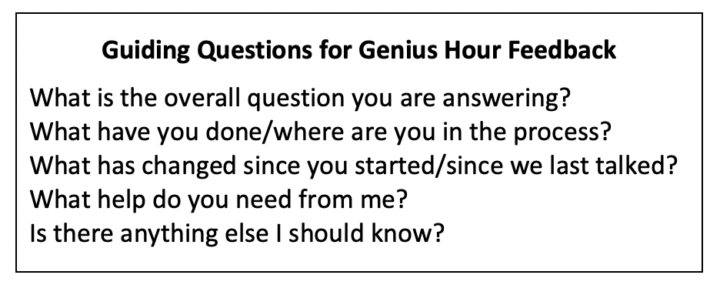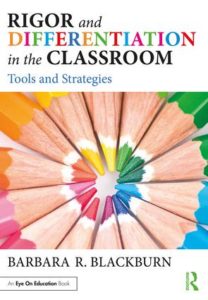Ready for Genius Hour? Do This, Not That.
 By Barbara R. Blackburn
By Barbara R. Blackburn
Genius Hour is an excellent way to encourage students to explore topics of interest and help school become a place of passionate learning.
The Genius Hour concept was originally inspired by Google executives, who noted in a 2004 corporate report that 20% of employees’ time was available to pursue ideas driven by personal passion and curiosity (Gmail and Google News are among the projects said to have emerged from the “20-percent time”).
Google’s goal was to develop happier, more creative, and more productive workers. Since then, many educators have adapted this approach for the classroom, shaping the concept to provide students regular time to pursue their own passions.
When we apply Genius Hour with students and allow them freedom to design their own learning and explore their own interests, they experience increases in intrinsic sense of purpose. Many schools are now implementing Genius Hour or some variation, which typically occurs for a minimum of one hour per week.
If you are interested in creating an opportunity like this in your classroom or school, here are some do’s and don’ts I would recommend.
Do This
Terry Heick of TeachThought describes six principles of Genius Hour. By integrating these principles, your students are more likely to be successful.
There are several strategies that can help you structure Genius Hour to ensure success of all students. First, once students have identified a topic, ask them to give an “Elevator Pitch” which is a three-minute talk proposing the idea. They can present this to other students or to you. Next, provide an opportunity for students to gain periodic feedback from you and other students.

Finally, be sure to provide an opportunity for students to rehearse their presentations. Too often, we expect students to perform without practicing, which is unfair. You might have them present to a partner or to a small group.
Not This
We must also consider the things NOT to do, since they can derail your efforts to increase learning through Genius Hour. First, don’t allow total choice without providing guidance and support.
Students work best when there is some structure and guided support when needed. For example, one teacher I met allowed total free choice on the topics. Predictably, he had a few students who took advantage of that freedom to choose “easy” topics that were more suited to elementary school. Let students know you expect they will challenge themselves in some way.
When I was a teacher, I allowed choice in many assignments (not just Genius Hour) using the following criteria. You may find it helpful, but it is also appropriate to have less structure since Genius Hour is designed to be student-driven. You know your students best. Over time, you may find they can handle more freedom.

One of the biggest mistakes you can make is to assume that you need to be a traditional teacher who controls the classroom. Rather, you will be facilitating the learning, allowing students to drive their own instruction.
Another “Don’t Do This” is to forget to leave time for processing and reflection. Due to schedule demands, teachers may try to rush the Genius Hour process. When we do this, students are not allowed time to connect their learning to other concepts, gain feedback from you and other students, or explore questions in depth. Finally, as a part of the rush to finish the process, we can push students to present their final product without practicing their presentation, or without completing it with more depth.
A Final Note
Genius Hour is a popular strategy for increasing the depth of student learning, as well as enhancing student motivation and engagement. Paying attention to the do’s and don’ts of effective implementation can help you incorporate it in your instruction.
Read more Genius Hour ideas here at MiddleWeb
































